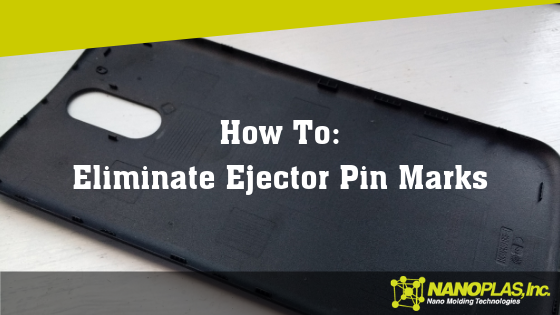
Ejector pin marks, sometimes called pin push, are the glossy or white imprints caused by the ejector pins that show on the class-A surface of the part. These marks can easily crack during the use of the actual products, so you want to prevent ejector pin marks before they happen.
What Causes Ejector Pin Marks?
When the ejector pins try to push the part out of the mold, sometimes the mold sticks, which causes the pin marks to appear on the finished part. However, the issue may not always be with the mold itself, but rather the molding process, machine, or materials.
The most common culprits include:
- Over-high injection pressure, over-fast dwell time, overflow mold temperature accompanied by an over-fast or unbalanced cooling speed, which altogether increase the internal stress of products.
- Over-small draft, incorrect or insufficient spraying of the mold-release agent or an over-large ejection resistance.
- Improper design of the ejector unit and over-fast ejection speeds can result in large ejection stress among the plastic and ejector parts.
- Improper design of structure for the products.
How to Eliminate Ejector Pin Marks in Injection Molding
All the above causes create unnecessary internal stress for the molding of products, so we need to reduce the ejection resistance and stress being applied by the ejector pins on the plastic parts.
- Avoid excessive injection of melt.
- Reduce injection pressure and dwell pressure. Shorten dwell time.
- Reduce injection rate, optimize the design of the feed system and realize a sound mold filling.
- Properly improve mold temperature, prolong cooling time and reduce cooling speed. Optimize temperature control and product structure to encourage uniform cooling of products in the mold.
- Increase draft while ensuring proper retaining mode of plastic parts in the mold.
- Analyze the ejection resistance and distribution, then use a suitable ejection mold with properly arranged ejector pins, trying to achieve a balanced ejection. If you see large ejection resistance, increase the number of ejector pins in those areas and expand the section dimensions of the ejector pin. Increase wall thickness where the ejector mark can easily occur in an effort to strengthen the products’ resistance to stress.
- Increase smoothness for the cavity surface. Polish along the ejection direction of plastic parts in the final stage of polishing. If you’re polishing a mold that already has ejector pin marks, apply polish corresponding to the ejector mark.
- Properly spray the mold-release agent.
Nanoplas Mold Release Products
The best way to solve ejector pin marks is with our Heat Cure™ and Quick Cure coatings. These injection mold coatings are applied either in your tool room or on the press and give exceptional release characteristics to the part in the mold, allowing it to eject without sticking and thereby eliminating any pin push marks.
If the only solution is to use a spray, try our Tuff-Kote and Dri-Kote high-performance mold-release sprays. The sprays go on light and last for many shots, as opposed to other sprays that go on heavier and can cause buildup in the mold, which can lead to later release issues or downtime to clean the molds.
Try our industry leading mold release agents for yourself, request a sample today!
